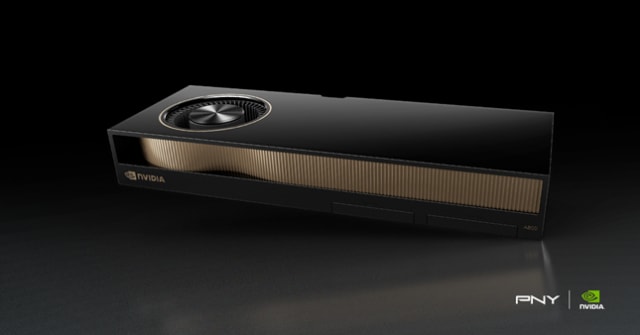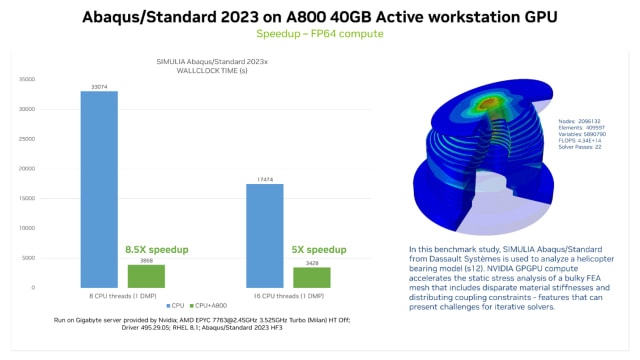The latest GPU from NVIDIA is ideal for compute-intensive CAE workloads that demand FP64. Here’s why it matters.
PNY has sponsored this post.
The fields of engineering simulation and high performance computing (HPC) have consistently been at the forefront of engineering advancements. The introduction of the NVIDIA® A800 40GB Active professional GPU marks a significant step forward in this relentless pursuit of compute performance.
The NVIDIA A800 40GB Active is designed to cater to the most demanding computer aided engineering (CAE) workloads requiring FP64 (double precision) compute. This GPU is ideal for advanced simulation when used with a companion GPU like the NVIDIA RTX 4000 Ada Generation, NVIDIA RTX A4000, or the NVIDIA T1000 8GB for the onscreen graphical presentation of results since the A800 40GB Active itself is a headless board (no video outputs). It allows today’s engineering community to transition more of the product development process in-silico, before machining metal, molding plastic or 3D printing to fabricate prototypes.

The importance of FP64 to engineering simulations
The primary advantage of FP64 (double-precision compute) is its ability to maintain a high level of numerical precision. In CAE, computations involve solving large sets of partial differential equations that model physical phenomena such as fluid dynamics, structural mechanics and thermodynamics.
FP64’s expanded exponent range and mantissa width enable the representation of both very large and very small numbers with greater accuracy. This is crucial when dealing with calculations that have a wide dynamic range or when the results are highly sensitive to numerical errors, which is often the case in engineering simulations.
For instance, in finite element analysis (FEA), small errors in numerical computation can propagate through the model, leading to significant discrepancies in the final results. FP64 minimizes these errors, thereby enhancing the fidelity and reliability of simulations. It is particularly beneficial for iterative solvers in FEA, where the accumulation of rounding errors can be detrimental to the convergence and stability of the solution process.
Engineering simulations often involve complex geometries and boundary conditions that can introduce challenges in numerical stability and convergence. FP64 offers the robustness required to handle these complexities effectively. In computational fluid dynamics (CFD) the simulation of turbulent flows or shock waves requires capturing a range of scales and gradients that can only be resolved accurately with high precision.
In multiphysics simulations where different physical processes are coupled together, discrepancies in one field can quickly propagate to others. FP64’s ability to maintain precision across different scales ensures that the interactions between physical phenomena are modeled accurately, which is imperative for making informed engineering decisions.
As engineering problems become more complex and the demand for higher-fidelity simulations grows, the scalability of CAE tools is of utmost importance. FP64 computation provides a pathway to scale simulations to larger and more detailed models without sacrificing accuracy.
Furthermore, with the advent of HPC and parallel processing inherent to GPUs, FP64 arithmetic ensures that as models scale across more processors, the consistency and accuracy of the results are maintained. This consistency is especially vital for large-scale simulations that span across thousands of cores, where even minor errors can amplify and lead to divergent results.
In the field of materials engineering, the development of new materials with complex properties often requires the precision that FP64 provides. Advanced materials such as composites or metamaterials exhibit behaviors that are highly sensitive to changes in loading conditions and environmental factors. Accurate simulations enable engineers to predict how these materials will perform in real-world applications, which is critical for innovative design and manufacturing.
Additionally, in the design phase, CAE tools with FP64 capabilities allow for the optimization of components to an unprecedented level of detail. This leads to designs that are not only more efficient and effective but also optimized for sustainability and longevity.
Reduction of physical prototyping and testing
The increased accuracy afforded by FP64 directly translates to a reduction in the need for physical prototypes and testing. By being able to trust the results of simulations, engineers can reduce the number of physical iterations needed, thereby saving time and resources. This not only accelerates the design process but also reduces material waste and the environmental impact associated with manufacturing multiple prototypes.

This is especially relevant in the aerospace and automotive industries, where safety and performance are critical, and the cost of prototyping can be exorbitant. High-fidelity simulations can replicate real-world conditions with such precision that physical testing can be reserved for final verification rather than for exploratory studies or early design validation.
Data integrity and traceability
In engineering projects, maintaining data integrity and traceability throughout the simulation process is vital for validation and certification purposes. FP64 supports this by ensuring that numerical errors do not lead to data corruption. This is particularly important in industries where certification by regulatory bodies is required, and there is no room for ambiguity about the reliability of the simulation data. Engineers can extract more nuanced insights from their simulations, enabling them to make more informed decisions about their designs.
NVIDIA A800 40GB Active architecture highlights
First introduced in the NVIDIA Volta™ architecture, NVIDIA Tensor Core technology has brought dramatic speedups to AI training and inference operations for AI-enhanced engineering applications. The NVIDIA Ampere architecture builds upon these innovations by providing up to 20x higher FLOPS for AI. It does so by improving the performance of existing precisions and bringing new precisions—TF32, INT8 and FP64—that accelerate and simplify AI adoption and extend the power of NVIDIA Tensor Cores to engineering simulation and HPC.

Not every engineering application needs the performance of a full A800 40GB Active GPU. Multi-Instance GPU (MIG) maximizes GPU-accelerated infrastructure utilization by allowing an A800 40GB Active GPU to be partitioned into as many as seven independent instances, fully isolated at the hardware level. This provides multiple engineers access to GPU acceleration with their own high-bandwidth memory, cache and compute cores, with guaranteed quality of service.
To feed its massive computational throughput, the NVIDIA A800 40GB Active GPU has 40GB of high speed HBM2 memory with a blazing 1,555GB/s of memory bandwidth—a 79 percent increase compared to NVIDIA Quadro® GV100. In addition to 40GB of HBM2 memory, the A800 40GB Active has significantly more on-chip memory, including a 40MB Level 2 (L2) cache, which is nearly seven times larger than the previous generation.
“We are excited by the level of performance that the A800 40GB Active delivers. With its powerful FP64 capabilities, we can accelerate simulation runtime, the image processing and geometric deep learning workloads that power our Virtual Twin Experiences,”says Simon Berard, Real Discovery and Deep Learning Technology Director at Dassault Systèmes.
Third-generation NVIDIA NVLink™ provides GPU performance scaling and memory pooling by bridging two NVIDIA A800 40GB Active cards to increase memory capacity to 80GB with near linear performance scaling by effectively doubling CUDA and Tensor Core counts. Scaling applications across multiple GPUs requires extremely fast movement of data. NVLink in A800 40GB Active provides 400GB/s of GPU-to-GPU direct bandwidth.
Core counts for the graphics board are impressive with 6912 CUDA and 432 Gen 3 Tensor Cores, delivering up to 9.7 TFLOPS of FP64, 19.5 TFLOPS of FP32, 311.8 TFLOPS of TF32, 1347.4 TOPS of INT8, and 1248 TOPS of INT4 performance. The Tensor Core results given here are with structural sparsity enabled.
A key GPU for CAE
The NVIDIA A800 40GB Active professional GPU offers significant benefits to engineering product development workflows requiring FP64 precision and HPC. With its innovative NVIDIA Ampere architecture, capacious memory capacity and bandwidth, and compatibility with industry-standard workstations, it can play a key role in advancing the capabilities of CAE to design more reliable products in less time, while significantly lowering development costs.
For additional information, explore NVIDIA A800 40GB Active at pny.com.



